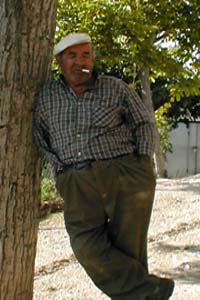 On a hot summer
afternoon in June, Anna Erbarosa and her daughter, Roberta, served a "snack,"
homemade prosciutto, salami, Easter cake, biscotti cookies, bread, and red
and white wine specific to the Le Marche region. Unselfishly, they served
us--five American journalists and our translator--and only sat down at the
crowded table once they were satisfied with what they had made. They delight
in doing this sort of thing: feeding their friends and family as if it were
a small party. Our friend, Flavio Trassana, who introduced us to the Federici
family, commented to us,
On a hot summer
afternoon in June, Anna Erbarosa and her daughter, Roberta, served a "snack,"
homemade prosciutto, salami, Easter cake, biscotti cookies, bread, and red
and white wine specific to the Le Marche region. Unselfishly, they served
us--five American journalists and our translator--and only sat down at the
crowded table once they were satisfied with what they had made. They delight
in doing this sort of thing: feeding their friends and family as if it were
a small party. Our friend, Flavio Trassana, who introduced us to the Federici
family, commented to us,
 "We were at war [Italy
and America] and now we are eating around the same table." "We were at war [Italy
and America] and now we are eating around the same table."
 Before our meal,
Anna took us on a tour of her home and described a typical day at the farm.
Anna has breakfast on the table at 7 a.m. sharp. She spends the rest of
the morning outside tending the farm and doing basic chores. Promptly at
noon, she serves lunch when her children and grandchildren return to the
house to eat. The rest of the afternoon, she feeds the animals and finishes
other chores. By 6:30, Anna returns to her kitchen to prepare dinner. Before our meal,
Anna took us on a tour of her home and described a typical day at the farm.
Anna has breakfast on the table at 7 a.m. sharp. She spends the rest of
the morning outside tending the farm and doing basic chores. Promptly at
noon, she serves lunch when her children and grandchildren return to the
house to eat. The rest of the afternoon, she feeds the animals and finishes
other chores. By 6:30, Anna returns to her kitchen to prepare dinner.
 While she was talking,
she led us up a rocky dirt path to her small yet productive vineyard; two
long rows of grapevines lined a hill overlooking Cagli. In June it is important
to water the trees, Anna told us, so the grapes will be ripe and ready to
pick in October. Surrounding the grapevines are almond and chestnut trees,
as well as a gelaso tree, which is used to attract silk worms. Anna takes
the silkworms into town and uses the silk as a means of income. The Federicis
are subsistence farmers; their farm provides all their income. Marcegina
cows, pigeons, ducks, and chickens are their food resources that live on
the farm together. While she was talking,
she led us up a rocky dirt path to her small yet productive vineyard; two
long rows of grapevines lined a hill overlooking Cagli. In June it is important
to water the trees, Anna told us, so the grapes will be ripe and ready to
pick in October. Surrounding the grapevines are almond and chestnut trees,
as well as a gelaso tree, which is used to attract silk worms. Anna takes
the silkworms into town and uses the silk as a means of income. The Federicis
are subsistence farmers; their farm provides all their income. Marcegina
cows, pigeons, ducks, and chickens are their food resources that live on
the farm together.  Along
with food, they make their own wine. Anna took us to the underground stone
wine cellar. Within the cellar, 8 large, rounded, empty vats line two sides
of the walls. Each vat has a spout, which serves as a taste tester to determine
the readiness of the wine. The torcchio, a traditional wine press with a
slanted funnel-like opening, guides the juices into large rope-covered jugs.
The Federicis use these jugs to transfer juice into the vats. Then, the
juice ferments for two to three months until it is ready. Along
with food, they make their own wine. Anna took us to the underground stone
wine cellar. Within the cellar, 8 large, rounded, empty vats line two sides
of the walls. Each vat has a spout, which serves as a taste tester to determine
the readiness of the wine. The torcchio, a traditional wine press with a
slanted funnel-like opening, guides the juices into large rope-covered jugs.
The Federicis use these jugs to transfer juice into the vats. Then, the
juice ferments for two to three months until it is ready.
 Running a farm is
hard work; Anna's husband and farm owner, Frederico Federici, contributes
as much as he can. However, he lost his arm in a machinery accident, and
Anna considers herself "his other arm." Despite the fact that her daily
work is arduous, Anna still took time to share her farm proudly. Anna and
the Federici family's warm hospitality is characteristic of Cagli. Running a farm is
hard work; Anna's husband and farm owner, Frederico Federici, contributes
as much as he can. However, he lost his arm in a machinery accident, and
Anna considers herself "his other arm." Despite the fact that her daily
work is arduous, Anna still took time to share her farm proudly. Anna and
the Federici family's warm hospitality is characteristic of Cagli.
|

Frederico Federici
owns the farm and vineyard
Anna Erbarosa, Federico's wife, prepares our midday meal
|





